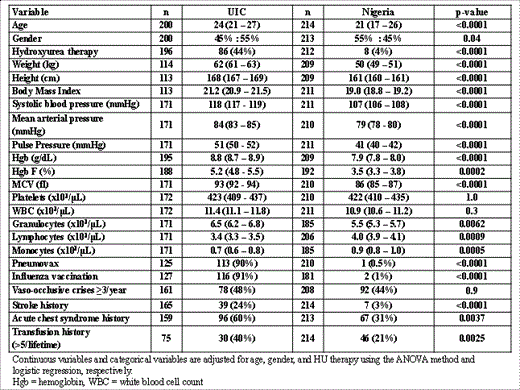Abstract
Sickle cell anemia (SCA) is among the most common monogenetic diseases worldwide and environmental and genetic factors are thought to contribute to variations in clinical presentation. We conducted a study to compare clinical and laboratory features between 214 SCA patients from the University of Ibadan, Nigeria and 200 SCA patients from the University of Illinois at Chicago, U.S. between the ages of 11 and 30 years old. Laboratory and clinical data were collected from clinic visits and comparisons between the two cohorts were adjusted for age, gender, and hydroxyurea use.
SCA patients from Nigeria had lower median body weight, height, body mass index, systolic blood pressure, mean arterial pressure and pulse pressure (Table 1). Proportions of hydroxyurea use and vaccinations for streptococcus pneumoniae and influenza A were lower in SCA patients from Nigeria. Hematological indices showed that SCA patients from Nigeria had lower median values for hemoglobin F (HbF) percent, hemoglobin concentration and mean corpuscular volume but platelet and white blood cell counts were not significantly different compared to SCA patients from the U.S. In the white blood cell differential, lower granulocyte counts and higher lymphocyte and monocyte counts were observed in SCA patients from Nigeria.
The proportion of patients with a history of ≥ 3 vaso-occlusive pain episodes requiring medical attention per year were similar between the Nigerian and U.S. cohorts but the proportions with histories of stroke, acute chest syndrome and > 5 lifetime transfusions were lower in the Nigerian versus U.S. cohort. On logistic regression analysis, male gender was independently associated with vaso-occlusive crises ≥ 3 per year in the Nigerian cohort (OR 1.9, 95% CI 1.1 – 3.4, p=0.04) and lower HbF concentration was associated with this pain category in the U.S. cohort (Hb F 1% decrement OR 1.1, 95% CI 1.0 – 1.1, p=0.02). A higher white blood cell count was independently associated with stroke history in both the Nigerian and U.S. cohorts (Nigeria: OR 1.1, 95% CI 1.0 - 1.3, p=0.03; US: OR 1.2, 95% CI 1.1 – 1.3, p=0.003). Additionally, a lower HbF concentration was independently associated with stroke history in the Nigerian cohort (Hb F 1% decrement OR 2.5, 95% CI 0.2 – 0.9, p=0.03).
The lower height and low proportions of vaccination among the Nigerian SCA patients point to the need for improved nutrition and vaccination strategies, and the low utilization of hydroxyurea therapy highlights the need to investigate the appropriateness of this agent in the African context. On the other hand, the higher values for BMI and blood pressure in the UIC compared to Nigerian SCA patients parallel similar findings in non-sickle cell cohorts and raises the possibility that life-style factors may contribute to the higher rate of stroke in the UIC cohort. Whether the lower rate of complications in general in the Nigerian SCA patients reflects higher early mortality versus favorable genetic or environmental factors deserves further investigation. In summary, our study found both differences and similarities between patients with SCA from Nigeria and the U.S. and a better understanding of the genetic and environmental contributions may help guide future therapies for SCA in both settings.
No relevant conflicts of interest to declare.
Author notes
Asterisk with author names denotes non-ASH members.


This feature is available to Subscribers Only
Sign In or Create an Account Close Modal